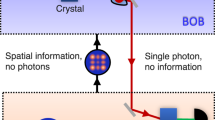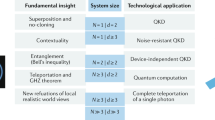Abstract
Photons are the ideal carriers of quantum information for communication1,2. Each photon can have a single or multiple qubits encoded in its internal quantum state, as defined by optical degrees of freedom such as polarization, wavelength, transverse modes and so on3,4. However, as photons do not interact, multiplexing and demultiplexing the quantum information across photons has not been possible hitherto. Here, we introduce and demonstrate experimentally a physical process, named ‘quantum joining’, in which the two-dimensional quantum states (qubits) of two input photons are combined into a single output photon, within a four-dimensional Hilbert space. The inverse process is also proposed, in which the four-dimensional quantum state of a single photon is split into two photons, each carrying a qubit. Both processes can be iterated, and hence provide a flexible quantum interconnect to bridge multiparticle protocols of quantum information with multidegree-of-freedom ones, with possible applications in future quantum networking5.
This is a preview of subscription content, access via your institution
Access options
Subscribe to this journal
Receive 12 print issues and online access
$209.00 per year
only $17.42 per issue
Buy this article
- Purchase on Springer Link
- Instant access to full article PDF
Prices may be subject to local taxes which are calculated during checkout




Similar content being viewed by others
References
Bennett, C. H. & DiVincenzo, D. P. Quantum information and computation. Nature 404, 247–255 (2000).
O'Brien, J. L., Furusawa, A. & Vucković, J. Photonic quantum technologies. Nature Photon. 3, 687–695 (2009).
Straupe, S. & Kulik, S. Quantum optics: the quest for higher dimensionality. Nature Photon. 4, 585–586 (2010).
Pile, D. How many bits can a photon carry? Nature Photon. 6, 14–15 (2012).
Kimble, H. J. The quantum internet. Nature 453, 1023–1030 (2008).
Ladd, T. D. et al. Quantum computers. Nature 464, 45–53 (2010).
Pan, J. W. et al. Multiphoton entanglement and interferometry. Rev. Mod. Phys. 84, 777–838 (2012).
Yao, X. C. et al. Observation of eight-photon entanglement. Nature Photon. 6, 225–228 (2012).
Mair, A., Alipasha, V., Weihs, G. & Zeilinger, A. Entanglement of the orbital angular momentum states of photons. Nature 412, 313–316 (2001).
Barreiro, J. T., Langford, N. K., Peters, N. A. & Kwiat, P. G. Generation of hyperentangled photon pairs. Phys. Rev. Lett. 95, 260501 (2005).
Molina-Terriza, G., Torres, J. P. & Torner, L. Twisted photons. Nature Phys. 3, 305–310 (2007).
Lanyon, B. P. et al. Simplifying quantum logic using higher-dimensional Hilbert spaces. Nature Phys. 5, 134–140 (2009).
Ceccarelli, R., Vallone, G., De Martini, F., Mataloni, P. & Cabello, A. Experimental entanglement and nonlocality of a two-photon six-qubit cluster state. Phys. Rev. Lett. 103, 160401 (2009).
Nagali, E. et al. Experimental optimal cloning of four-dimensional quantum states of photons. Phys. Rev. Lett. 105, 73602 (2010).
Gao, W. B. et al. Experimental demonstration of a hyper-entangled ten-qubit Schrödinger cat state. Nature Phys. 6, 331–335 (2010).
Dada, A. C., Leach, J., Buller, G. S., Padgett, M. J. & Andresson, E. Experimental high-dimensional two-photon entanglement and violations of generalized Bell inequalities. Nature Phys. 7, 677–680 (2011).
Bennett, C. H. et al. Teleporting an unknown quantum state via dual classical and Einstein–Podolsky–Rosen channels. Phys. Rev. Lett. 70, 1895–1899 (1993).
Bouwmeester, D. et al. Experimental quantum teleportation. Nature 390, 575–579 (1997).
Boschi, D., Branca, S., De Martini, F., Hardy, L. & Popescu, S. Experimental realization of teleporting an unknown pure quantum state via dual classical and Einstein–Podolsky–Rosen channels. Phys. Rev. Lett. 80, 1121–1125 (1998).
Knill, E., Laflamme, R. & Milburn, G. J. A scheme for efficient quantum computation with linear optics. Nature 409, 46–52 (2001).
Kok, P. et al. Linear optical quantum computing with photonic qubits. Rev. Mod. Phys. 79, 135–174 (2007).
Hong, C. K., Ou, Z. Y. & Mandel, L. Measurement of subpicosecond time intervals between two photons by interference. Phys. Rev. Lett. 59, 2044–2046 (1987).
Pittman, T. B., Jacobs, B. C. & Franson, J. D. Probabilistic quantum logic operations using polarizing beam splitters. Phys. Rev. A 64, 062311 (2001).
Pittman, T. B., Fitch, M. J., Jacobs, B. C. & Franson, J. D. Experimental controlled-not logic gate for single photons in the coincidence basis. Phys. Rev. A 68, 032316 (2003).
Gasparoni, S., Pan, J. W., Walther, P., Rudolph, T. & Zeilinger, A. Realization of a photonic controlled-not gate sufficient for quantum computation. Phys. Rev. Lett. 93, 020504 (2004).
Zhao, Z. et al. Experimental demonstration of a nondestructive controlled-not quantum gate for two independent photon qubits. Phys. Rev. Lett. 94, 030501 (2005).
Sansoni, L. et al. Polarization entangled state measurement on a chip. Phys. Rev. Lett. 105, 200503 (2010).
Munro, W. J., Stephens, A. M., Devitt, S. J., Harrison, K. H. & Nemoto, K. Quantum communication without the necessity of quantum memories. Nature Photon. 6, 777–781 (2012).
Julsgaard, B., Sherson, J., Cirac, J. I., Fiurasek, J. & Polzik, E. S. Experimental demonstration of quantum memory for light. Nature 432, 482–486 (2004).
Eibl, M. et al. Experimental observation of four-photon entanglement from parametric down-conversion. Phys. Rev. Lett. 90, 200403 (2003).
Acknowledgements
This work was supported by the 7th Framework Programme of the European Commission, within the Future Emerging Technologies programme, under grant No. 255914, PHORBITECH, and by the Italian Ministry for Education, University and Research, within the Futuro in Ricerca programme, under grant HYTEQ.
Author information
Authors and Affiliations
Contributions
L.M., with contributions from F.S. and E.S., developed the qubit joining/splitting concept and the corresponding optical schemes. C.V., N.S. and F.S. designed the experimental layout and methodology and, with L.A., carried out the experiments. N.S., C.V. and F.S. developed the model of partial photon distinguishability. All authors discussed the results and participated in preparing the manuscript.
Corresponding authors
Ethics declarations
Competing interests
The authors declare no competing financial interests.
Supplementary information
Supplementary information
Supplementary information (PDF 1115 kb)
Rights and permissions
About this article
Cite this article
Vitelli, C., Spagnolo, N., Aparo, L. et al. Joining the quantum state of two photons into one. Nature Photon 7, 521–526 (2013). https://doi.org/10.1038/nphoton.2013.107
Received:
Accepted:
Published:
Issue Date:
DOI: https://doi.org/10.1038/nphoton.2013.107
This article is cited by
-
A review of electro-optic, semiconductor optical amplifier and photonic crystal-based optical switches for application in quantum computing
Journal of Optics (2023)
-
All-optical scheme for implementation of tri-state Pauli-X, Y and Z quantum gates using phase encoding
Optoelectronics Letters (2021)
-
Implementation of a single-photon fully quantum router with cavity QED and linear optics
Optical and Quantum Electronics (2021)
-
All-optical integrated square root of Pauli-Z (SRZ) gates using polarization and phase encoding
Journal of Optics (2019)
-
Implementation of polarization-encoded quantum Toffoli gate
Journal of Optics (2019)



